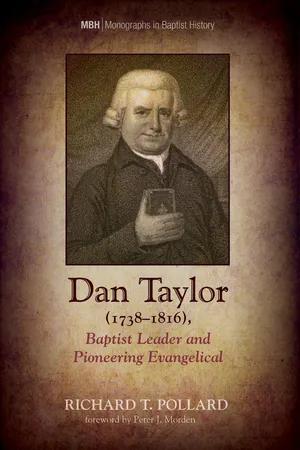![]()
1
Emergent Evangelical
Dan Taylor first encountered the Evangelical Revival at William Grimshaw’s parish church in Haworth, West Riding. Through the preaching of Grimshaw and other evangelicals, he gained an understanding of the gospel that differed from that which he had acquired during his earlier years. All that Taylor found to be new, both within the preached message and how the gospel was communicated, will be considered. Attention will be given to his nine-year involvement in the structures of Methodism as he participated in society, class, and band meetings at the Methodist society in Halifax. The commitment with which he embraced much of what was distinctive about eighteenth-century evangelicalism will be examined and how this became evident in his later practical embodiment of evangelical values, his structural initiatives and teaching. The extent to which his evangelicalism was manifest in the dynamics of his personal spirituality and how this highlights something of the discontinuity between evangelicalism and earlier movements such as Puritanism, will be explored. Lastly, consideration will be given to certain reasons and influences that contributed to his decision to leave Methodism.
Taylor’s Introduction to the Evangelical Revival
“meat and drink”
During the mid-1750s Taylor traveled many miles with his younger brother John to hear evangelical preachers. In particular, they made frequent visits to Haworth to listen to the preaching of William Grimshaw. John Walsh, in his examination of eighteenth-century evangelical clergy in Yorkshire, describes Grimshaw as “the dominating figure of the period.” He became perpetual curate at Haworth Parish Church in 1742, previously serving eleven years as a curate at Todmorden where, he spent his first seven years enjoying a lifestyle of carefree indulgence. A turning point came in 1738 when (among other factors) he read a sermon on justification by faith by the prominent evangelical Robert Seagrave. Grimshaw then decided “to embrace Christ only for my all in all,” abandoned his loose living, renounced his merit based understanding of salvation and dedicated himself to preaching faith in Christ crucified and risen as the only means of salvation from sin. The twelve regular communicants at Haworth in 1742 soon grew to a gathering of over a thousand people during the summer months. As John Laycock described, Grimshaw became “one of the greatest evangelists in the North of England.” At the time when Taylor traveled to hear Grimshaw, growth in numbers was still taking place. This was reflected in a 1754 letter from Grimshaw who wrote, “I bless the Lord. His work still spreads and flourishes on all sides of us.” Three years later, he similarly wrote “Our congregations . . . are larger,” “several souls are added” and “some are seemingly just now awakening.” The Taylors’ visits to Haworth, between 1753–62, also saw them introduced to the preaching of other leading evangelicals who were provided the “best hospitality” by Grimshaw. These included John and Charles Wesley, and George Whitefield whose ministries further contributed to how “the revival was expanding and consolidating in Yorkshire.” Taylor was both a witness of this revival and willing participant.
The preached message of the need to place faith in Christ as the Son of God, who died for the sins of the world and for each person individually, was “instrumental” in helping Taylor gain “clearer views of the plan of mercy through a redeemer.” Taylor experienced that which David Hempton draws attention to as a characteristic of Methodist preaching during the Evangelical Revival. Hempton states that while the message was “neither uniform nor completely formulaic . . . it spoke of the possibility of salvation and a new start, not at the dictates of authoritarian divinity, but as the result of divine love inspiring a willing human response.” Having been exposed to this, Taylor considered his inherited understanding of the gospel as deficient. A typical example of the criticism he expressed regarding his earlier experience of faith was how he had “often been heard to say, that if the gospel had been preached as it ought to have been, he should have obtained liberty much sooner.” Neither his attendance of worship at Halifax Parish Church, nor his parents’ Bible teaching gave him the clarity of gospel understanding that he gained from evangelical preachers. This was despite his parents’ best efforts. John Taylor noted that their mother had diligently sought to instruct her children in the truths of Scripture and that their father possessed “much more knowledge of the holy Scriptures than working men...
